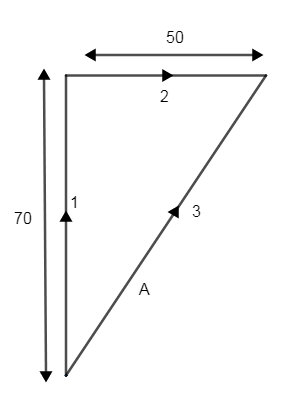
How can I draw a velocity vector diagram?
Answer
538.2k+ views
Hint: Velocity diagrams are the diagrams that use a vector arrow to indicate the direction and the relative magnitude of a vector quantity. To define the velocity of a moving object during the phase, vector diagrams may be used. For instance to depict the motion of a car going down the road, a vector diagram may be used.
Complete answer:
The magnitude of a vector quantity is expressed by the scale of the vector arrow in a vector diagram if the arrow size is the same in each consecutive frame of the vector diagram, then the vector magnitude is constant. The diagram below shows a car's speeds during its motion. The scale of the velocity vector is constant in the top diagram so the diagram represents a motion of the constant velocity. The velocity vector size is increasing in the bottom diagram as we see one example.
Let's understand the velocity diagram with the example.
Assume that a bus is travelling at the velocity of the 70km/h.
After that bus turns in east and continues at the reduce speed of 50km/h
Now let’s check what resultant velocity is,

As we can see from the figure the first vector shown as line 1 which has speed of 70km/h and the second vector is shown as line 2 and ‘A’ vector is a resultant vector of the both speed of the line 1 and 2
This is how we can draw vector diagrams.
Note:
As an approach to solve this question first we have seen a definition of the velocity diagram which states that the velocity diagram can be used to describe the velocity of a moving object during its motion as we have seen by an example of the bus.
Complete answer:
The magnitude of a vector quantity is expressed by the scale of the vector arrow in a vector diagram if the arrow size is the same in each consecutive frame of the vector diagram, then the vector magnitude is constant. The diagram below shows a car's speeds during its motion. The scale of the velocity vector is constant in the top diagram so the diagram represents a motion of the constant velocity. The velocity vector size is increasing in the bottom diagram as we see one example.
Let's understand the velocity diagram with the example.
Assume that a bus is travelling at the velocity of the 70km/h.
After that bus turns in east and continues at the reduce speed of 50km/h
Now let’s check what resultant velocity is,

As we can see from the figure the first vector shown as line 1 which has speed of 70km/h and the second vector is shown as line 2 and ‘A’ vector is a resultant vector of the both speed of the line 1 and 2
This is how we can draw vector diagrams.
Note:
As an approach to solve this question first we have seen a definition of the velocity diagram which states that the velocity diagram can be used to describe the velocity of a moving object during its motion as we have seen by an example of the bus.
Recently Updated Pages
Master Class 12 Business Studies: Engaging Questions & Answers for Success

Master Class 12 Economics: Engaging Questions & Answers for Success

Master Class 12 English: Engaging Questions & Answers for Success

Master Class 12 Maths: Engaging Questions & Answers for Success

Master Class 12 Social Science: Engaging Questions & Answers for Success

Master Class 12 Chemistry: Engaging Questions & Answers for Success

Trending doubts
What is meant by exothermic and endothermic reactions class 11 chemistry CBSE

Which animal has three hearts class 11 biology CBSE

10 examples of friction in our daily life

One Metric ton is equal to kg A 10000 B 1000 C 100 class 11 physics CBSE

1 Quintal is equal to a 110 kg b 10 kg c 100kg d 1000 class 11 physics CBSE

Difference Between Prokaryotic Cells and Eukaryotic Cells




